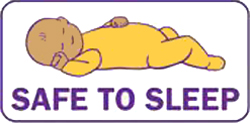
In April 1992, the
American Academy of Pediatrics recommended that healthy infants be encouraged to sleep on their backs because of evidence that it might reduce the risk of SIDS in infants . In 1994, the Back to Sleep Campaign was officially launched in the US by the American Academy of Pediatrics (AAP), SIDS Alliance (now First Candle), and
National Institute of Child Health and Human Development (NICHD) . Since its inception this campaign focused on heightening awareness among parents, health care providers and other caregivers about the benefits of placing a baby to sleep on his or her back. The Back to Sleep Campaign became a nationwide public health effort with the NICHD having major responsibility for distributing educational and informational materials on this crucial health topic. Between1992 and 2001, SIDS rates in the United States declined by over 50 percent. This dramatic decrease has been attributed to more infants being placed to sleep on their backs and is based on national surveys conducted during this ten year period.
In recent years the rate of SIDS has plateaued and other causes of sudden unexpected infant death (SUID) occurring during sleep including suffocation, asphyxia and entrapment and other ill defined causes of infant deaths, have increased. The American Academy of Pediatrics (AAP) released a Policy Statement, SIDS and Other Sleep-Related Infant Deaths: Expansion of Recommendations for a Safe Infant Sleeping Environment and an accompanying Technical Report on October 18, 2011. The AAP in these new guidelines expanded its previous risk reduction recommendations by focusing on a safe sleep environment that can reduce the risk of all sleep-related infant deaths including SIDS. The 2011 AAP recommendations largely reinforce those originally published in 2005; but they add a number of important guidelines and also clarify others such as the recommendation regarding room sharing without bed sharing.
These safe sleep measures outlined by the AAP have been incorporated into the Eunice Kennedy Shriver National Institute of Child Health and Human Development's (NICHD) expanded public education activities now known as the Safe to Sleep Campaign. Using the success of the former Back to Sleep Campaign, this outreach effort launched in October 2012, includes strategies to educate parents, caregivers and health care providers about ways to reduce the risk of SIDS and other sleep-related infant deaths such as suffocation.
What are the key messages of the Safe to Sleep Campaign on ways to reduce the risk of SIDS and other sleep-related causes of infant death?
Always place a baby on his or her back to sleep for naps and at night, to reduce the risk of SIDS.
Put baby to sleep in a separate sleep area in the same room where you sleep. If you bring baby into your bed to breastfeed, make sure to put him or her back into a separate sleep area, such as a safety approved crib, bassinet or portable play area when you are finished.
Use a firm sleep surface, covered by a fitted sheet, to reduce the risk of SIDS and other sleep-related causes of death. Remove all loose bedding, soft objects and toys.